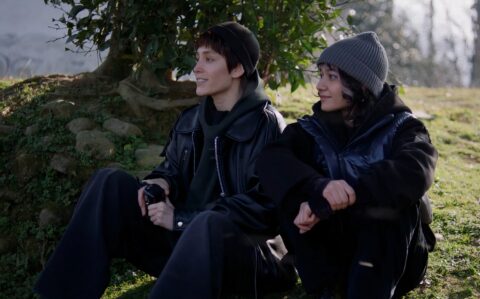Any queer person living in a big city knows the sting of returning to a small town. It means stepping back into a version of your life that denies who you are now. Farnoosh Samadi’s aptly titled new thriller, Between Dreams and Hope (2025), playing in Platform, captures this uneasy return, exploring what it means to live in the space between who you are and what the world allows — between identity and survival, between the future you imagine and the limits you’re forced to navigate.
The film opens with a strange, ominous dream — signalling that reality won’t be any easier. From there, we settle into the daily life of a queer couple in Tehran. Azad (Fereshteh Hosseini), a trans man, lives with his partner Nora (Sadaf Asgari). Their world is small but filled with care: a modest apartment and a relationship rooted in tenderness and trust. That fragile calm is shaken when Azad learns he must return to his hometown to get a signature from his estranged father — who rejected him years ago — to complete his medical transition.
We get an early taste of what Azad is up against, even in the bustling capital. On his way into a clinic for gender-affirming care, he’s stopped by a security guard who demands he wear a hijab. The request erases his masculinity and reduces him to a state-sanctioned fiction. It’s surreal, but entirely plausible, capturing the exhausting, often humiliating microaggressions trans people endure just to access basic care. Even at the entrance to a place meant to offer safety and change, the system insists on dictating how bodies are seen.
At the core of the film lies a painful dilemma. Azad must choose between indefinite delay in Tehran, where his transition stalls under mounting legal obstacles, or a possibly dangerous return to his rural hometown, where he’ll have to face the man who cast him out. The choice extends beyond personal trauma — it mirrors the impossible decisions queer people are forced into, stuck between competing forms of risk and compromise.
The setup feels a bit forced, and the constant close-ups sometimes beg for more visual variety, but the film pushes through these limitations and comes to life elsewhere. Samadi offers a glimpse of queer solidarity in a rave scene, filtered through the surreal haze of magic mushrooms. Among fellow queer Iranians, a quiet consensus takes shape: real freedom may only be possible elsewhere. But Azad and Nora choose to stay. What first looks like character development or background detail turns out to be something closer to foreshadowing. The film makes it clear — they won’t back down when danger becomes real, and that choice shapes everything that follows.
Midway through, the film pivots into thriller territory. The tonal shift brings tension, but doesn’t always deliver as sharply as it could. Without spoiling specifics (though TIFF’s synopsis already does), something goes terribly wrong at Azad’s father’s house, triggering a frantic search across town. One character becomes trapped in a repetitive cycle — asking the same question, chasing answers that remain just out of reach. It’s a smart reflection of the bureaucratic and emotional standstills queer people often face, but the script struggles to stop going in circles for a little while. The rural setting is thick with menace and claustrophobia, ripe for a tense cat-and-mouse game, yet the film hesitates, never fully diving into the suspense it hints at.
Despite those mid-film stumbles and a few contrivances, Between Dreams and Hope regains its footing with a powerful final act. For anyone who’s experienced familial rejection, these final scenes land with a visceral ache. And while the film was completed well before recent headlines, it resonates powerfully in the current climate, where the death of a right-wing podcaster in the U.S. has sparked a wave of baseless, inflammatory attacks on trans people and leftists. The timing is coincidental, but the film’s relevance is chilling. It forces an urgent question: how do you survive in a world that wants you gone, especially when that violence begins at home? How long can you keep turning the other cheek before something inside you breaks?
The answer erupts like a lion waking from a long sleep, roaring through a room that’s stayed quiet for too long — a refusal to be pulled into the dead-inside rejection of self that patriarchy demands. It’s not clean or easy, but for these two characters, it’s clearly necessary. Queer audiences will feel it deep in their bones.
The epilogue unfolds slowly and gently, stretching into the closing credits. It’s intimate and honest, and by far the best-looking sequence in the film. Rather than offering closure, it lingers — visually and emotionally insisting on the sheer effort required to stay afloat in currents designed to drag you under. And it leaves you with a simple truth: when families and systems fail, it’s often other queers who end up throwing a life preserver.
Editor-at-large Jared loves movies and lives with Kiki in Berlin.
